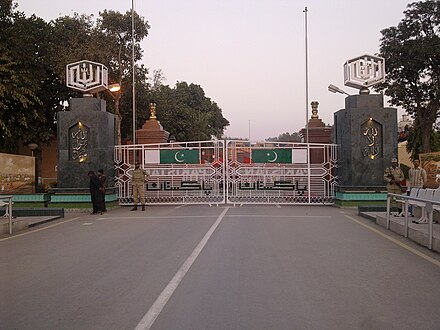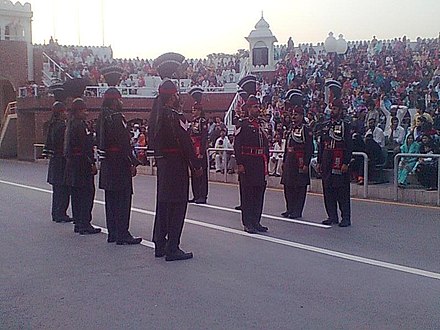
Wagah (or Wagha) is a border town straddling the line between Pakistan and India, 29 km from the town of Lahore on the Pakistani side and 27 km from Amritsar on the Indian side. This is the only crossing point between Pakistan and India that is regularly open to foreigners.
Get in
The closest significant towns to Wagah are Amritsar in India and Lahore in Pakistan.
By train
The Samjhauta Express from Lahore to Delhi passes through Wagah. The last station on the Indian side is Attari. This train runs twice weekly, on Tuesdays and Fridays. As of December 2022, it is not operating.
- Wagah railway station. 2022-06-23
By road
When driving from Islamabad, it should take 4.5 hours minimum.

From Lahore Station, take a bus, taxi or the Metro and a shared rickshaw. Minibus No. 4 might leave from outside Lahore Railway Station every 15 minutes for about 50 Rs while a taxi should cost 1,900 Rs. For a cheaper ride, use auto rickshaws: when leaving the train station, go left and find the departing point for shared rickshaws where they are waiting until they're filled up. There will be one going to Wagah, or more likely Jallo More (about 150 Rs), from where you will find another one towards Wagah border (50-100 Rs). Expect the whole ride to take around an hour.
Another more comfortable option (especially in summer) is to use the modern Orange Metro Line until its Eastern terminus, Dera Gujran (20-40 Rs depending on where you board) and take a shared rickshaw from the station exit towards Wagah border (about 100 Rs).
From Amritsar, Wagah is about 45 minutes away by car. There are public buses to Attari station, from where you can continue the last 3 km to the border by cyclerickshaw. A rickshaw all the way to Amritsar will be between 300 and 500 INR.
Most tourists can take a taxi through their hotels for a round trip, which includes the waiting time at Wagah. As of 2009, a typical fare for such a trip from Amritsar was about ₹800. The fare for auto was ₹400.
Get around
 If you're planning to cross the border, you should aim to get there as early as possible. As of 2022, the border is open every day from 08:30 to 15:30. Border formalities can take from 30 minutes to over two hours, and you will need to arrange a proper visa before you arrive. E-visa don't entitle the holder to cross here.
If you're planning to cross the border, you should aim to get there as early as possible. As of 2022, the border is open every day from 08:30 to 15:30. Border formalities can take from 30 minutes to over two hours, and you will need to arrange a proper visa before you arrive. E-visa don't entitle the holder to cross here.
Regular buses or taxis are not allowed into the no-man's land between the countries, so unless you're on one of the few deluxe international buses, you'll have to walk across the 500 m between the border posts yourself. Porters, blue coats for the Indians and green coats for the Pakistanis, can carry your belongings for a few dollars.
See
 There is daily flag raising and lowering ceremony at Wagah Border, which is done with pomp and ceremony. It involves some of the tallest members of the Indian Border Force and the Pakistani Rangers marching and closing the many gates. It has become a tradition for people from both sides of the border to gather and see this. Both sides synchronise their parade and the entire event is meant to create a feel-good/patriotic fervour amongst the crowd. It is called the beating retreat ceremony. Since 2010, the Wagha ceremony has begun to tone down so one might see less of the flourishing of Peacock helmets and goose-stepping.
There is daily flag raising and lowering ceremony at Wagah Border, which is done with pomp and ceremony. It involves some of the tallest members of the Indian Border Force and the Pakistani Rangers marching and closing the many gates. It has become a tradition for people from both sides of the border to gather and see this. Both sides synchronise their parade and the entire event is meant to create a feel-good/patriotic fervour amongst the crowd. It is called the beating retreat ceremony. Since 2010, the Wagha ceremony has begun to tone down so one might see less of the flourishing of Peacock helmets and goose-stepping.
The flag lowering ceremony which happens around 16:00 everyday has become the main event for tourists. In addition, there is now a short cultural programme also done by local folk dancers (Bhangra) for the waiting crowd before the flag lowering. A peak crowd of up to 2,000 people can assemble on the Indian side and up and over 1,000 people on the Pakistani side. The crowd consists of tourists & locals. The noise and atmosphere of the assembled crowds on both sides of the border is similar to that of a sporting match and very entertaining.
The border gates have a visitor gallery on each side, basically concrete steps created around the border main road. This allows most people in the crowd to get a seat but it is not uncommon to see up to 500-1,000 people standing at the periphery. There are metal fences to help direct and control the crowds in and out of the seating areas.
Ideally, one should reach the border gates by 15:30 to get seating if you're going on a busy day.
The seating area is as follows:
- VIP seating - closest to the gates and requires a special pass which can be made from the BSF station near the Amritsar bypass road a couple of days in advance.
- Ladies exclusive - a section where only women and small children are allowed. This comes after the VIP seating and is little further from the gates (about 80 m away)
- General seating - tends to get very crowded and congested during rush days. Occasional pushing/jostling may happen.
Do not bring any bags. No covered bags, including women's purses & handbags, are allowed inside the visitor areas. Mobile phones, cameras and men's wallets are allowed, but leave the camera bag. However, border personnel allow clear plastic bags with few snacks, water, children's food etc. There are no cloak rooms. The restrictions are usually dependent on the crowd and perceived security alertness on that day.
Taxis and cars must be parked about 500 m away from the entry gates to the border area. You will need to walk in and reach the visitor gallery. Stay to the left side until you reach the grandstands.

 Be prepared for minor traffic jams when the ceremony has finished as up to 200-300 vehicles try to exit around the same time.
Be prepared for minor traffic jams when the ceremony has finished as up to 200-300 vehicles try to exit around the same time.
- There are no tickets to see this event, it is free for viewing for anyone on the Pakistani as well as the Indian side.
- As of December 2022, the border closes at 15:30. The flag lowering ceremony starts at 16:00 and lasts around half an hour, but you should be there in advance. On a normal day, there is no need to be there before the gates open, which should be between 15:30 and 15:45. The Indian part, however, seems to fill up more quickly so it is a good idea to be there in advance.
- Please note that because of border skirmishes in Kashmir and the escalating tensions between the two nations, the governments of India and Pakistan are not going to allow visas to be given in Wagha. Also, the people who can cross/the times of crossing will be restricted if the skirmishes continue.
Do
Relax at nearby Jallo Park, or enjoy in Suzo Water Park.
Buy
- You can buy some snacks/drinks at the entry gate and also along the roadside as you are walking the 500 or so metres to the seating area.
- There are many local male children who sell DVDs of the ceremony, costing around ₹20.
- Be careful of pickpockets.
Eat
There is an official tourist centre, called "Aman Umeed" at the entry gate. It is a nice clean facility with toilets etc. and has comfortable seating, although food options are very limited inside.
However, there are 2-3 large local food stalls outside the gate opposite the tourist centre which serve food, offer packaged snacks and soft drinks. You can take these inside when you watch the ceremony.
Drink
Water bottles are not allowed after the checking point of entry to Wagah border. So don't carry them from the car/coaches. If necessary, buy them at the stalls just near the gate.
Sleep
Connect
Mobile phones will not work here, as calls/SMSs are jammed.